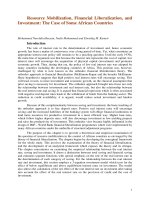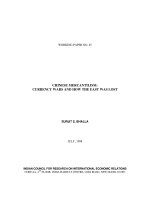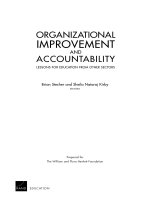organizational culture and environment the constraints
Bạn đang xem bản rút gọn của tài liệu. Xem và tải ngay bản đầy đủ của tài liệu tại đây (489.19 KB, 34 trang )
ninth edition
STEPHEN P. ROBBINS
© 2007 Prentice Hall, Inc.
© 2007 Prentice Hall, Inc.
All rights reserved.
All rights reserved.
PowerPoint Presentation by Charlie Cook
PowerPoint Presentation by Charlie Cook
The University of West Alabama
The University of West Alabama
MARY COULTER
Organizational Culture
Organizational Culture
and Environment:
and Environment:
The Constraints
The Constraints
Chapter
Chapter
3
3
© 2007 Prentice Hall, Inc. All rights
reserved.
3–2
L E A R N I N G O U T L I N E
L E A R N I N G O U T L I N E
Follow this Learning Outline as you read and study this chapter.
Follow this Learning Outline as you read and study this chapter.
•
The Manager: Omnipotent or Symbolic
The Manager: Omnipotent or Symbolic
•
Contrast the action of manager according to the
Contrast the action of manager according to the
omnipotent and symbolic views.
omnipotent and symbolic views.
•
Explain the parameters of managerial discretion.
Explain the parameters of managerial discretion.
•
The Organization’s Culture
The Organization’s Culture
•
Describe the seven dimensions of organizational culture.
Describe the seven dimensions of organizational culture.
•
Discuss the impact of a strong culture on organizations
Discuss the impact of a strong culture on organizations
and managers.
and managers.
•
Explain the source of an organization’s culture.
Explain the source of an organization’s culture.
•
Describe how culture is transmitted to employees.
Describe how culture is transmitted to employees.
•
Describe how culture affects managers.
Describe how culture affects managers.
© 2007 Prentice Hall, Inc. All rights
reserved.
3–3
L E A R N I N G O U T L I N E (cont’d)
L E A R N I N G O U T L I N E (cont’d)
Follow this Learning Outline as you read and study this chapter.
Follow this Learning Outline as you read and study this chapter.
•
Current Organizational Cultural Issues Facing
Current Organizational Cultural Issues Facing
Managers
Managers
•
Describe the characteristics of an ethical culture, an
Describe the characteristics of an ethical culture, an
innovative culture, and a customer-responsive culture.
innovative culture, and a customer-responsive culture.
•
Discuss why workplace spirituality seems to be an
Discuss why workplace spirituality seems to be an
important concern.
important concern.
•
Describe the characteristics of a spiritual organization.
Describe the characteristics of a spiritual organization.
© 2007 Prentice Hall, Inc. All rights
reserved.
3–4
L E A R N I N G O U T L I N E (cont’d)
L E A R N I N G O U T L I N E (cont’d)
Follow this Learning Outline as you read and study this chapter.
Follow this Learning Outline as you read and study this chapter.
•
The Environment (cont’d)
The Environment (cont’d)
•
Describe the components of the specific and general
Describe the components of the specific and general
environments.
environments.
•
Discuss the two dimensions of environmental
Discuss the two dimensions of environmental
uncertainty.
uncertainty.
•
Identify the most common organizational stakeholders.
Identify the most common organizational stakeholders.
•
Explain the four steps in managing external stakeholder
Explain the four steps in managing external stakeholder
relationships.
relationships.
© 2007 Prentice Hall, Inc. All rights
reserved.
3–5
The Manager: Omnipotent or Symbolic?
The Manager: Omnipotent or Symbolic?
•
Omnipotent View of Management
Omnipotent View of Management
Managers are directly responsible for an
Managers are directly responsible for an
organization’s success or failure.
organization’s success or failure.
The quality of the organization is determined by the
The quality of the organization is determined by the
quality of its managers.
quality of its managers.
Managers are held accountable
Managers are held accountable
for an organization’s performance
for an organization’s performance
yet it is difficult to attribute
yet it is difficult to attribute
good or poor performance
good or poor performance
directly to their influence
directly to their influence
on the organization.
on the organization.
© 2007 Prentice Hall, Inc. All rights
reserved.
3–6
The Manager: Omnipotent or Symbolic?
The Manager: Omnipotent or Symbolic?
•
Symbolic View of Management
Symbolic View of Management
Much of an organization’s success or failure is due to
Much of an organization’s success or failure is due to
external forces outside of managers’ control.
external forces outside of managers’ control.
The ability of managers to affect outcomes is
The ability of managers to affect outcomes is
influenced and constrained by external factors.
influenced and constrained by external factors.
The economy, customers, governmental policies,
The economy, customers, governmental policies,
competitors, industry conditions,
competitors, industry conditions,
technology, and the actions of
technology, and the actions of
previous managers
previous managers
Managers symbolize control and
Managers symbolize control and
influence through their action.
influence through their action.
© 2007 Prentice Hall, Inc. All rights
reserved.
3–7
Exhibit 3–1
Exhibit 3–1
Parameters of Managerial Discretion
Parameters of Managerial Discretion
© 2007 Prentice Hall, Inc. All rights
reserved.
3–8
The Organization’s Culture
The Organization’s Culture
•
Organizational Culture
Organizational Culture
A system of shared meanings and common beliefs
A system of shared meanings and common beliefs
held by organizational members that determines, in a
held by organizational members that determines, in a
large degree, how they act towards each other.
large degree, how they act towards each other.
“
“
The way we do things around here.”
The way we do things around here.”
Values, symbols, rituals, myths, and practices
Values, symbols, rituals, myths, and practices
Implications:
Implications:
Culture is a perception.
Culture is a perception.
Culture is shared.
Culture is shared.
Culture is descriptive.
Culture is descriptive.
© 2007 Prentice Hall, Inc. All rights
reserved.
3–9
Exhibit 3–2
Exhibit 3–2
Dimensions of Organizational Culture
Dimensions of Organizational Culture
© 2007 Prentice Hall, Inc. All rights
reserved.
3–10
Exhibit 3–3
Exhibit 3–3
Contrasting Organizational Cultures
Contrasting Organizational Cultures
Dimension
Dimension
Organization A
Organization A
Organization B
Organization B
Attention to Detail
Attention to Detail
High
High
Low
Low
Outcome Orientation
Outcome Orientation
Low
Low
High
High
People Orientation
People Orientation
Low
Low
High
High
Team Orientation
Team Orientation
Low
Low
High
High
Aggressiveness
Aggressiveness
Low
Low
High
High
Stability
Stability
High
High
Low
Low
Innovation and Risk Taking
Innovation and Risk Taking
Low
Low
High
High
© 2007 Prentice Hall, Inc. All rights
reserved.
3–11
Strong versus Weak Cultures
Strong versus Weak Cultures
•
Strong Cultures
Strong Cultures
Are cultures in which key values are deeply held and
Are cultures in which key values are deeply held and
widely held.
widely held.
Have a strong influence on organizational members.
Have a strong influence on organizational members.
•
Factors Influencing the Strength of Culture
Factors Influencing the Strength of Culture
Size of the organization
Size of the organization
Age of the organization
Age of the organization
Rate of employee turnover
Rate of employee turnover
Strength of the original culture
Strength of the original culture
Clarity of cultural values and beliefs
Clarity of cultural values and beliefs
© 2007 Prentice Hall, Inc. All rights
reserved.
3–12
Benefits of a Strong Culture
Benefits of a Strong Culture
•
Creates a stronger employee commitment to the
Creates a stronger employee commitment to the
organization.
organization.
•
Aids in the recruitment and socialization of new
Aids in the recruitment and socialization of new
employees.
employees.
•
Fosters higher organizational
Fosters higher organizational
performance by instilling and
performance by instilling and
promoting employee initiative.
promoting employee initiative.
© 2007 Prentice Hall, Inc. All rights
reserved.
3–13
Organizational Culture
Organizational Culture
•
Sources of Organizational Culture
Sources of Organizational Culture
The organization’s founder
The organization’s founder
Vision and mission
Vision and mission
Past practices of the organization
Past practices of the organization
The way things have been done
The way things have been done
The behavior of top management
The behavior of top management
•
Continuation of the Organizational Culture
Continuation of the Organizational Culture
Recruitment of like-minded employees who “fit”
Recruitment of like-minded employees who “fit”
Socialization
Socialization
of new employees to help them adapt
of new employees to help them adapt
to the culture
to the culture
© 2007 Prentice Hall, Inc. All rights
reserved.
3–14
Exhibit 3–4
Exhibit 3–4
Strong versus Weak Organizational Cultures
Strong versus Weak Organizational Cultures
© 2007 Prentice Hall, Inc. All rights
reserved.
3–15
How Employees Learn Culture
How Employees Learn Culture
•
Stories
Stories
Narratives of significant events or actions of people that convey
Narratives of significant events or actions of people that convey
the spirit of the organization
the spirit of the organization
•
Rituals
Rituals
Repetitive sequences of activities that express and reinforce the
Repetitive sequences of activities that express and reinforce the
values of the organization
values of the organization
•
Material Symbols
Material Symbols
Physical assets distinguishing the organization
Physical assets distinguishing the organization
•
Language
Language
Acronyms and jargon of terms, phrases, and word meanings
Acronyms and jargon of terms, phrases, and word meanings
specific to an organization
specific to an organization
© 2007 Prentice Hall, Inc. All rights
reserved.
3–16
How Culture Affects Managers
How Culture Affects Managers
•
Cultural Constraints on Managers
Cultural Constraints on Managers
Whatever managerial actions the organization
Whatever managerial actions the organization
recognizes as proper or improper on its behalf
recognizes as proper or improper on its behalf
Whatever organizational activities the organization
Whatever organizational activities the organization
values and encourages
values and encourages
The overall strength or weakness of the
The overall strength or weakness of the
organizational culture
organizational culture
Simple rule for getting ahead in an organization:
Simple rule for getting ahead in an organization:
Find out what the organization rewards and do those things.
Find out what the organization rewards and do those things.
© 2007 Prentice Hall, Inc. All rights
reserved.
3–17
Exhibit 3–5
Exhibit 3–5
How an Organization’s Culture Is Established
How an Organization’s Culture Is Established
and Maintained
and Maintained
© 2007 Prentice Hall, Inc. All rights
reserved.
3–18
Exhibit 3–6
Exhibit 3–6
Managerial Decisions Affected by Culture
Managerial Decisions Affected by Culture
•
Planning
•
The degree of risk that plans should contain
•
Whether plans should be developed by individuals or teams
•
The degree of environmental scanning in which management
will engage
•
Organizing
•
How much autonomy should be designed into employees’ jobs
•
Whether tasks should be done by individuals or in teams
•
The degree to which department managers interact with each
other
© 2007 Prentice Hall, Inc. All rights
reserved.
3–19
Exhibit 3–6
Exhibit 3–6
Managerial Decisions Affected by Culture (cont’d)
Managerial Decisions Affected by Culture (cont’d)
•
Leading
•
The degree to which managers are concerned with increasing
employee job satisfaction
•
What leadership styles are appropriate
•
Whether all disagreements—even constructive ones—should
be eliminated
•
Controlling
•
Whether to impose external controls or to allow employees to
control their own actions
•
What criteria should be emphasized in employee performance
evaluations
•
What repercussions will occur from exceeding one’s budget
© 2007 Prentice Hall, Inc. All rights
reserved.
3–20
Organization Culture Issues
Organization Culture Issues
•
Creating an Ethical
Creating an Ethical
Culture
Culture
High in risk tolerance
High in risk tolerance
Low to moderate
Low to moderate
aggressiveness
aggressiveness
Focus on means as
Focus on means as
well as outcomes
well as outcomes
•
Creating an Innovative
Creating an Innovative
Culture
Culture
Challenge and
Challenge and
involvement
involvement
Freedom
Freedom
Trust and openness
Trust and openness
Idea time
Idea time
Playfulness/humor
Playfulness/humor
Conflict resolution
Conflict resolution
Debates
Debates
Risk-taking
Risk-taking
© 2007 Prentice Hall, Inc. All rights
reserved.
3–21
Exhibit 3–7
Exhibit 3–7
Suggestions for Managers: Creating a More Ethical Culture
Suggestions for Managers: Creating a More Ethical Culture
•
Be a visible role model.
•
Communicate ethical expectations.
•
Provide ethics training.
•
Visibly reward ethical acts and punish unethical
ones.
•
Provide protective mechanisms so employees can
discuss ethical dilemmas and report unethical
behavior without fear.
© 2007 Prentice Hall, Inc. All rights
reserved.
3–22
Organization Culture Issues (cont’d)
Organization Culture Issues (cont’d)
•
Creating a Customer-Responsive Culture
Creating a Customer-Responsive Culture
Hiring the right type of employees (ones with a strong
Hiring the right type of employees (ones with a strong
interest in serving customers)
interest in serving customers)
Having few rigid rules, procedures, and regulations
Having few rigid rules, procedures, and regulations
Using widespread empowerment of employees
Using widespread empowerment of employees
Having good listening skills in relating to customers’
Having good listening skills in relating to customers’
messages
messages
Providing role clarity to employees to reduce
Providing role clarity to employees to reduce
ambiguity and conflict and increase job satisfaction
ambiguity and conflict and increase job satisfaction
Having conscientious, caring employees willing to
Having conscientious, caring employees willing to
take initiative
take initiative
© 2007 Prentice Hall, Inc. All rights
reserved.
3–23
Exhibit 3–8
Exhibit 3–8
Suggestions for Managers: Creating a More Customer-
Suggestions for Managers: Creating a More Customer-
Responsive Culture
Responsive Culture
•
Hire service-contact people with the personality and attitudes
consistent with customer service—friendliness, enthusiasm,
attentiveness, patience, concern about others, and listening skills.
•
Train customer service people continuously by focusing on
improving product knowledge, active listening, showing patience,
and displaying emotions.
•
Socialize new service-contact people to the organization’s goals and
values.
•
Design customer-service jobs so that employees have as much
control as necessary to satisfy customers.
•
Empower service-contact employees with the discretion to make
day-to-day decisions on job-related activities.
•
As the leader, convey a customer-focused vision and demonstrate
through decisions and actions the commitment to customers.
© 2007 Prentice Hall, Inc. All rights
reserved.
3–24
Spirituality and Organizational Culture
Spirituality and Organizational Culture
•
Workplace Spirituality
Workplace Spirituality
The recognition that people have an inner life that
The recognition that people have an inner life that
nourishes and is nourished by meaningful work that
nourishes and is nourished by meaningful work that
takes place in the context of community.
takes place in the context of community.
•
Characteristics of a Spiritual Organization
Characteristics of a Spiritual Organization
Strong sense of purpose
Strong sense of purpose
Focus on individual development
Focus on individual development
Trust and openness
Trust and openness
Employee empowerment
Employee empowerment
Toleration of employees’ expression
Toleration of employees’ expression
© 2007 Prentice Hall, Inc. All rights
reserved.
3–25
Benefits of Spirituality
Benefits of Spirituality
•
Improved employee productivity
Improved employee productivity
•
Reduction of employee turnover
Reduction of employee turnover
•
Stronger organizational performance
Stronger organizational performance
•
Increased creativity
Increased creativity
•
Increased employee satisfaction
Increased employee satisfaction
•
Increased team performance
Increased team performance
•
Increased organizational performance
Increased organizational performance









